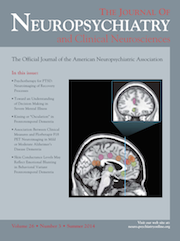To the Editor: Bartter syndrome is an autosomal recessive renal tubular disorder, which is characterized by renal salt wasting, hypokalemic metabolic alkalosis, elevated plasma renin activity, hyperaldosteronism, and normal blood pressure. Muscle weakness that involves the breathing or swallowing, fatigue, periodic mild paralysis, and muscle cramps resulting from severe loss of potassium and electrolyte imbalance are a common complaint among patients presenting to the emergent department.
1,2 In this case, we reported the patient with Bartter syndrome and mania like symptoms.
Case Report
A 33-year-old man, previously diagnosed with Bartter syndrome, was examined for the presence of psychiatric symptoms including restlessness, aggression, agitation, rapidly fluctuating emotions, talking to oneself, and suspicion and mistrust of the people in the nephrology clinic. According to the past medical and psychiatric history collected by interviewing his doctors and wife and screening the hospital patient registration system, the patient was diagnosed with kidney disease about 7 years ago and was often hospitalized for symptoms of severe fatigue and weakness of his muscles. Also during this period, he had insomnia, increased irritability, aggressiveness, violent behavior, grandiose and persecutory delusions, and emotional lability. The patient had been admitted to psychiatric unit, and a variety of psychotropic medications were given which he discontinued. The patient had no history of substance abuse or a family of mental disorder.
On psychiatric examination, decreased self-care; open conscious and normal orientation; answering appropriately to questions; visual hallucination; decreased concentration and attention; ideas of reference; grandiosity; illogical thinking; affective instability; dysphoric mood; irritability; increased psychomotor activity; aggressive behavior; having no insight; and decreased appetite and sleep were observed.
Serum laboratory values (10 follow-up days) were sodium (Na) 117, 119, 124, 129 mmol/L (136–145 range), potassium (K) 1.6, 1.89, 2.05, 2.77 mEq/L (3.5–5.1), magnesium (Mg) 2.21mg/dl (1.7–2.2), calcium (Ca) 9.29 mg/dl (8.8–9.2), alanine aminotransferase (ALT) 35 U/L (0–41), aspartate aminotransferase (AST) 26 U/L (0–37), blood urea nitrogen (BUN) 28 mg/dl (0–50), creatinine (Cr) 1.25 mg/dl (0.9–1.5), and phosphorus (P) 4.27 mg/dl (2.7–4.5), pH 7.53–7.46, pCO2 29–39, HCO3 24–27, SpO2 70–95.
Discussion
In this case, we suggest the possible etiological relationship between mania like symptoms and Bartter syndrome. Psychiatric symptoms of this patient manifest especially during hypokalemia, hyponatremia, and metabolic alkalosis. Hypokalemia has been determined in some patients presenting with acute psychotic episodes of schizophrenia.
3 The authors debated that a decline in the serum potassium concentration might be associated with the level of symptoms of acute agitation.
Neurochemical changes including thyroid diseases, vitamin B12 and folate deficiency, sodium-potassium imbalance, in combination, may contribute to the increased risk of mental disorders in vulnerable patients with medical disorders. These patients may exhibit cognitive, perceptual, emotional, and behavioral disturbances including confusion, impaired attention and memory skills, hallucinations, delusions, disorganized speech, agitation, aggressiveness, labile mood, and altered sleep-wake pattern.
4Some authors have suggested that electrolyte abnormalities may cause mood swings.
5,6 These studies have shown that both depression and mania are related to changes in the plasma sodium concentration. As in this case, it has been observed that rapid changes in plasma sodium levels may lead to mood fluctuations in manic-depressive patients.
6 In addition, it is well known that lithium is an effective treatment both for mania and depression. The effects of lithium treatment on the distribution of sodium and potassium suggest that changes of electrolytes may be of great importance in the etiology of affective disorders.
7Psychiatric symptoms secondary to metabolic alkalosis, particularly psychotic symptoms, has been reported in the literature. The psychosis of metabolic alkalosis may appear in both inpatients and outpatients with negative psychiatric histories, and exhibit auditory and visual hallucinations, paranoid and other delusions, confusion, disorganized thoughts or delirium, high energy levels, and agitated behaviors.
8Our patient achieved psychiatric symptoms remission subsequent treatment of severe hypokalemia, hyponatremia, and metabolic alkalosis. These findings suggest that electrolyte and acid-base imbalance can also play a role in the etiology of mental disorders

